CONTRACT 8 Business Law Assignment Problem Case Study 2017
VerifiedAdded on 2020/03/23
|8
|2030
|129
Case Study
AI Summary
This document presents a comprehensive case study analysis of a contract law problem involving Miles and Farmquip. The central issue revolves around a potential breach of contract concerning the sale of a tractor, focusing on the elements of contract formation, including offer, acceptance, and invitation to treat. The analysis delves into the concept of misrepresentation, where a false statement of fact was made by Farmquip's representative regarding the inclusion of air conditioning. The presence and validity of exclusion clauses within the contract are thoroughly examined, considering their insertion, notice, and impact on liability. The case study applies legal principles to determine Miles's potential claims for rescission of the contract due to misrepresentation and for damages arising from the breach of contract. It also considers the impact of the invalid exclusion clauses. The conclusion supports Miles's legal recourse against Farmquip for misrepresentation or breach of contract. The document provides relevant case law and legal principles supporting the analysis.

Paraphrase This Document
Need a fresh take? Get an instant paraphrase of this document with our AI Paraphraser
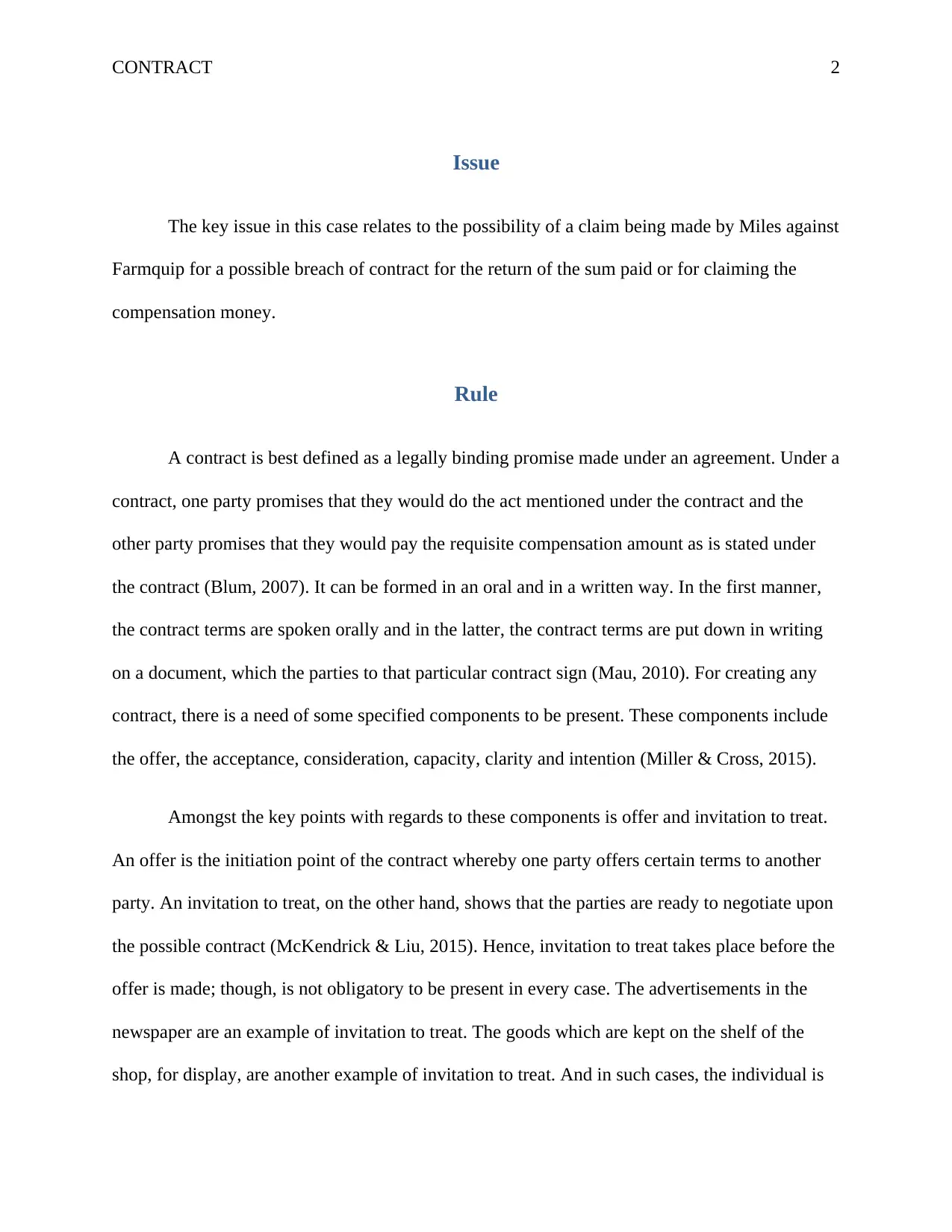
CONTRACT 2
Issue
The key issue in this case relates to the possibility of a claim being made by Miles against
Farmquip for a possible breach of contract for the return of the sum paid or for claiming the
compensation money.
Rule
A contract is best defined as a legally binding promise made under an agreement. Under a
contract, one party promises that they would do the act mentioned under the contract and the
other party promises that they would pay the requisite compensation amount as is stated under
the contract (Blum, 2007). It can be formed in an oral and in a written way. In the first manner,
the contract terms are spoken orally and in the latter, the contract terms are put down in writing
on a document, which the parties to that particular contract sign (Mau, 2010). For creating any
contract, there is a need of some specified components to be present. These components include
the offer, the acceptance, consideration, capacity, clarity and intention (Miller & Cross, 2015).
Amongst the key points with regards to these components is offer and invitation to treat.
An offer is the initiation point of the contract whereby one party offers certain terms to another
party. An invitation to treat, on the other hand, shows that the parties are ready to negotiate upon
the possible contract (McKendrick & Liu, 2015). Hence, invitation to treat takes place before the
offer is made; though, is not obligatory to be present in every case. The advertisements in the
newspaper are an example of invitation to treat. The goods which are kept on the shelf of the
shop, for display, are another example of invitation to treat. And in such cases, the individual is
Issue
The key issue in this case relates to the possibility of a claim being made by Miles against
Farmquip for a possible breach of contract for the return of the sum paid or for claiming the
compensation money.
Rule
A contract is best defined as a legally binding promise made under an agreement. Under a
contract, one party promises that they would do the act mentioned under the contract and the
other party promises that they would pay the requisite compensation amount as is stated under
the contract (Blum, 2007). It can be formed in an oral and in a written way. In the first manner,
the contract terms are spoken orally and in the latter, the contract terms are put down in writing
on a document, which the parties to that particular contract sign (Mau, 2010). For creating any
contract, there is a need of some specified components to be present. These components include
the offer, the acceptance, consideration, capacity, clarity and intention (Miller & Cross, 2015).
Amongst the key points with regards to these components is offer and invitation to treat.
An offer is the initiation point of the contract whereby one party offers certain terms to another
party. An invitation to treat, on the other hand, shows that the parties are ready to negotiate upon
the possible contract (McKendrick & Liu, 2015). Hence, invitation to treat takes place before the
offer is made; though, is not obligatory to be present in every case. The advertisements in the
newspaper are an example of invitation to treat. The goods which are kept on the shelf of the
shop, for display, are another example of invitation to treat. And in such cases, the individual is
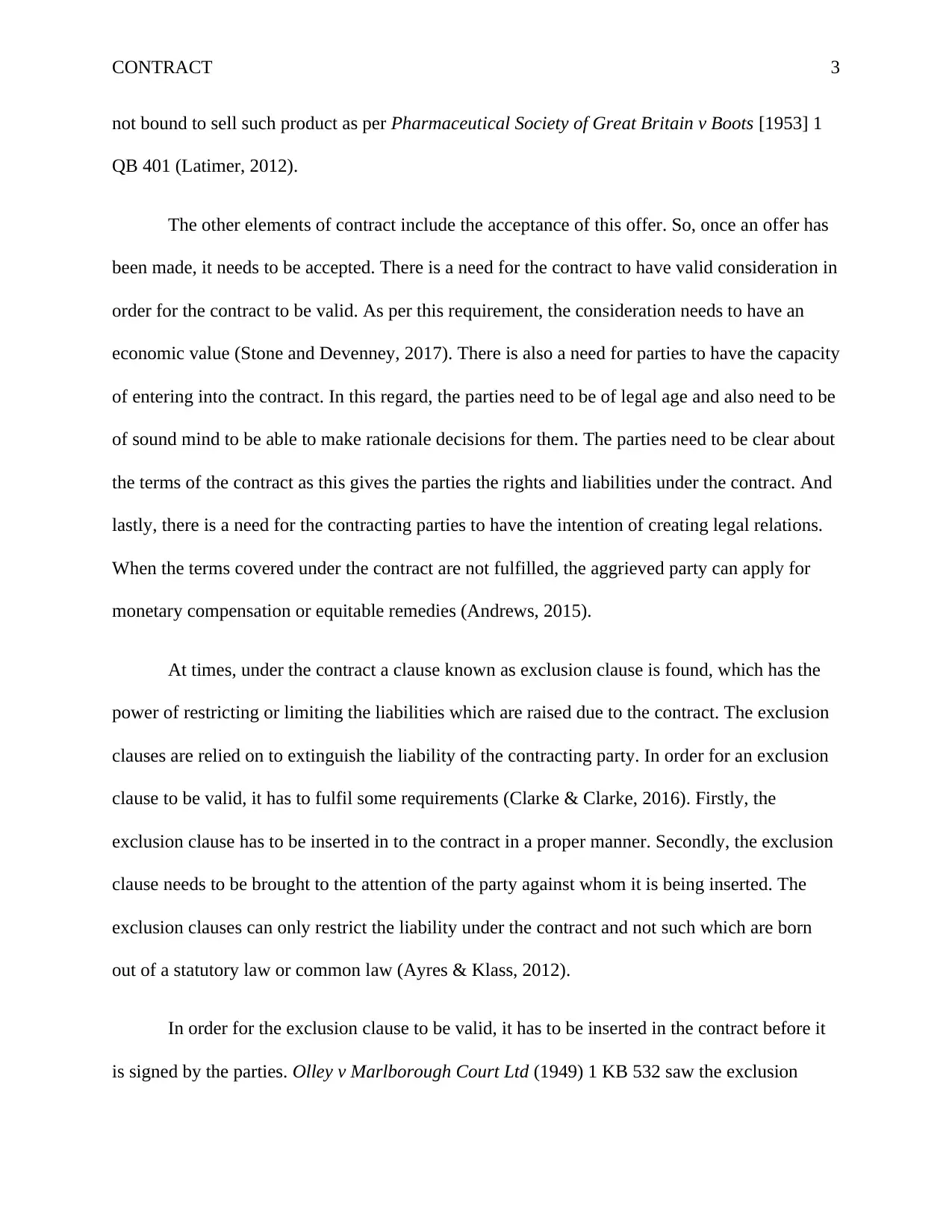
CONTRACT 3
not bound to sell such product as per Pharmaceutical Society of Great Britain v Boots [1953] 1
QB 401 (Latimer, 2012).
The other elements of contract include the acceptance of this offer. So, once an offer has
been made, it needs to be accepted. There is a need for the contract to have valid consideration in
order for the contract to be valid. As per this requirement, the consideration needs to have an
economic value (Stone and Devenney, 2017). There is also a need for parties to have the capacity
of entering into the contract. In this regard, the parties need to be of legal age and also need to be
of sound mind to be able to make rationale decisions for them. The parties need to be clear about
the terms of the contract as this gives the parties the rights and liabilities under the contract. And
lastly, there is a need for the contracting parties to have the intention of creating legal relations.
When the terms covered under the contract are not fulfilled, the aggrieved party can apply for
monetary compensation or equitable remedies (Andrews, 2015).
At times, under the contract a clause known as exclusion clause is found, which has the
power of restricting or limiting the liabilities which are raised due to the contract. The exclusion
clauses are relied on to extinguish the liability of the contracting party. In order for an exclusion
clause to be valid, it has to fulfil some requirements (Clarke & Clarke, 2016). Firstly, the
exclusion clause has to be inserted in to the contract in a proper manner. Secondly, the exclusion
clause needs to be brought to the attention of the party against whom it is being inserted. The
exclusion clauses can only restrict the liability under the contract and not such which are born
out of a statutory law or common law (Ayres & Klass, 2012).
In order for the exclusion clause to be valid, it has to be inserted in the contract before it
is signed by the parties. Olley v Marlborough Court Ltd (1949) 1 KB 532 saw the exclusion
not bound to sell such product as per Pharmaceutical Society of Great Britain v Boots [1953] 1
QB 401 (Latimer, 2012).
The other elements of contract include the acceptance of this offer. So, once an offer has
been made, it needs to be accepted. There is a need for the contract to have valid consideration in
order for the contract to be valid. As per this requirement, the consideration needs to have an
economic value (Stone and Devenney, 2017). There is also a need for parties to have the capacity
of entering into the contract. In this regard, the parties need to be of legal age and also need to be
of sound mind to be able to make rationale decisions for them. The parties need to be clear about
the terms of the contract as this gives the parties the rights and liabilities under the contract. And
lastly, there is a need for the contracting parties to have the intention of creating legal relations.
When the terms covered under the contract are not fulfilled, the aggrieved party can apply for
monetary compensation or equitable remedies (Andrews, 2015).
At times, under the contract a clause known as exclusion clause is found, which has the
power of restricting or limiting the liabilities which are raised due to the contract. The exclusion
clauses are relied on to extinguish the liability of the contracting party. In order for an exclusion
clause to be valid, it has to fulfil some requirements (Clarke & Clarke, 2016). Firstly, the
exclusion clause has to be inserted in to the contract in a proper manner. Secondly, the exclusion
clause needs to be brought to the attention of the party against whom it is being inserted. The
exclusion clauses can only restrict the liability under the contract and not such which are born
out of a statutory law or common law (Ayres & Klass, 2012).
In order for the exclusion clause to be valid, it has to be inserted in the contract before it
is signed by the parties. Olley v Marlborough Court Ltd (1949) 1 KB 532 saw the exclusion
⊘ This is a preview!⊘
Do you want full access?
Subscribe today to unlock all pages.

Trusted by 1+ million students worldwide
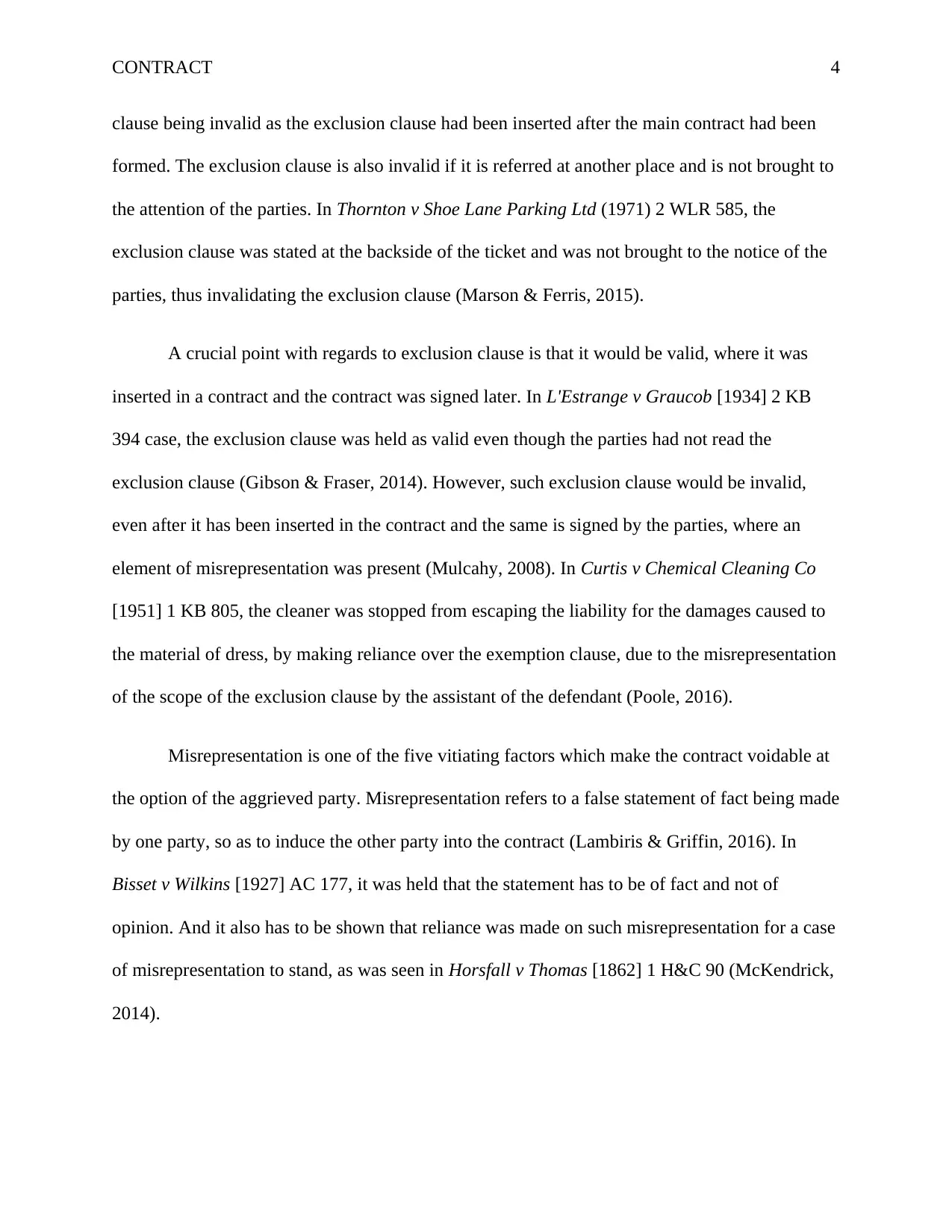
CONTRACT 4
clause being invalid as the exclusion clause had been inserted after the main contract had been
formed. The exclusion clause is also invalid if it is referred at another place and is not brought to
the attention of the parties. In Thornton v Shoe Lane Parking Ltd (1971) 2 WLR 585, the
exclusion clause was stated at the backside of the ticket and was not brought to the notice of the
parties, thus invalidating the exclusion clause (Marson & Ferris, 2015).
A crucial point with regards to exclusion clause is that it would be valid, where it was
inserted in a contract and the contract was signed later. In L'Estrange v Graucob [1934] 2 KB
394 case, the exclusion clause was held as valid even though the parties had not read the
exclusion clause (Gibson & Fraser, 2014). However, such exclusion clause would be invalid,
even after it has been inserted in the contract and the same is signed by the parties, where an
element of misrepresentation was present (Mulcahy, 2008). In Curtis v Chemical Cleaning Co
[1951] 1 KB 805, the cleaner was stopped from escaping the liability for the damages caused to
the material of dress, by making reliance over the exemption clause, due to the misrepresentation
of the scope of the exclusion clause by the assistant of the defendant (Poole, 2016).
Misrepresentation is one of the five vitiating factors which make the contract voidable at
the option of the aggrieved party. Misrepresentation refers to a false statement of fact being made
by one party, so as to induce the other party into the contract (Lambiris & Griffin, 2016). In
Bisset v Wilkins [1927] AC 177, it was held that the statement has to be of fact and not of
opinion. And it also has to be shown that reliance was made on such misrepresentation for a case
of misrepresentation to stand, as was seen in Horsfall v Thomas [1862] 1 H&C 90 (McKendrick,
2014).
clause being invalid as the exclusion clause had been inserted after the main contract had been
formed. The exclusion clause is also invalid if it is referred at another place and is not brought to
the attention of the parties. In Thornton v Shoe Lane Parking Ltd (1971) 2 WLR 585, the
exclusion clause was stated at the backside of the ticket and was not brought to the notice of the
parties, thus invalidating the exclusion clause (Marson & Ferris, 2015).
A crucial point with regards to exclusion clause is that it would be valid, where it was
inserted in a contract and the contract was signed later. In L'Estrange v Graucob [1934] 2 KB
394 case, the exclusion clause was held as valid even though the parties had not read the
exclusion clause (Gibson & Fraser, 2014). However, such exclusion clause would be invalid,
even after it has been inserted in the contract and the same is signed by the parties, where an
element of misrepresentation was present (Mulcahy, 2008). In Curtis v Chemical Cleaning Co
[1951] 1 KB 805, the cleaner was stopped from escaping the liability for the damages caused to
the material of dress, by making reliance over the exemption clause, due to the misrepresentation
of the scope of the exclusion clause by the assistant of the defendant (Poole, 2016).
Misrepresentation is one of the five vitiating factors which make the contract voidable at
the option of the aggrieved party. Misrepresentation refers to a false statement of fact being made
by one party, so as to induce the other party into the contract (Lambiris & Griffin, 2016). In
Bisset v Wilkins [1927] AC 177, it was held that the statement has to be of fact and not of
opinion. And it also has to be shown that reliance was made on such misrepresentation for a case
of misrepresentation to stand, as was seen in Horsfall v Thomas [1862] 1 H&C 90 (McKendrick,
2014).
Paraphrase This Document
Need a fresh take? Get an instant paraphrase of this document with our AI Paraphraser
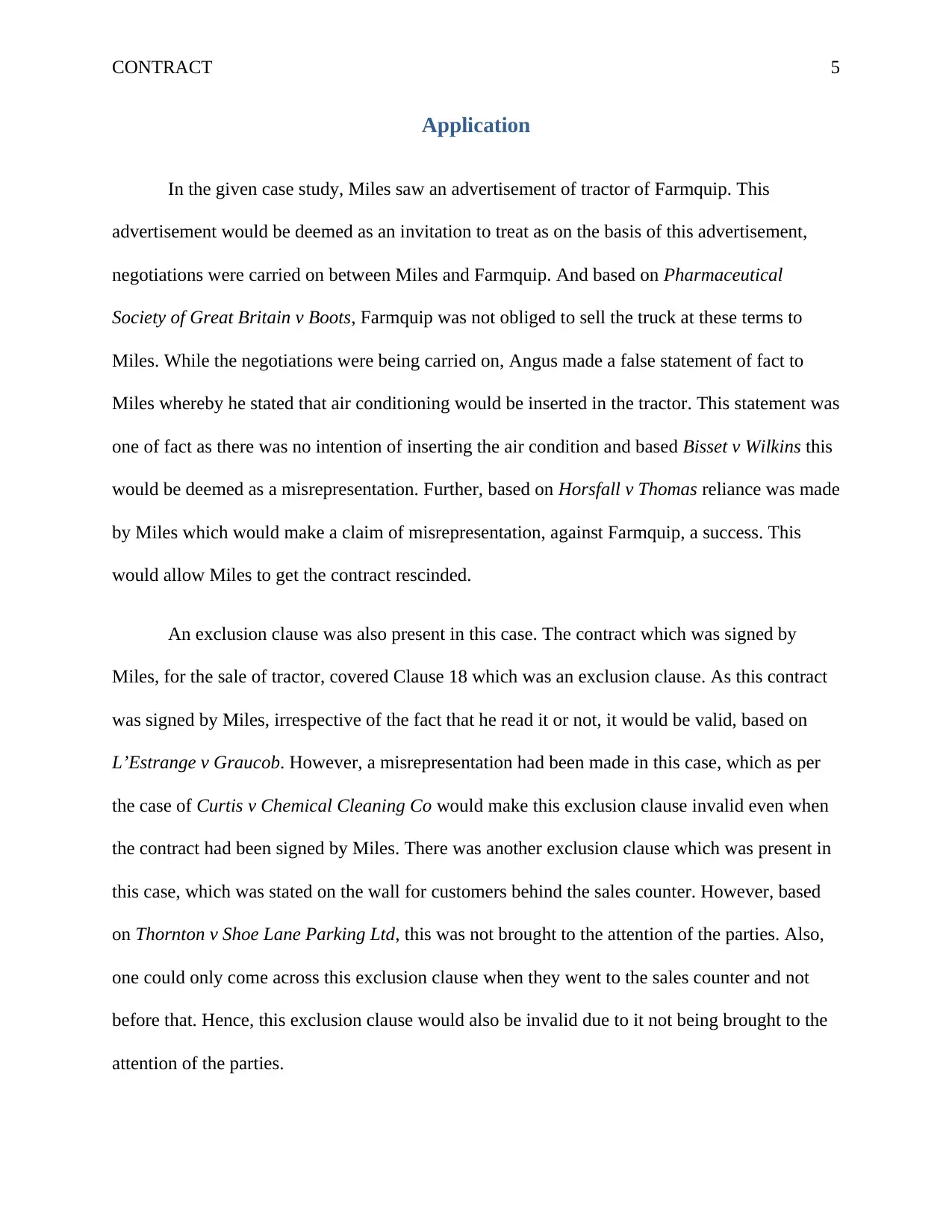
CONTRACT 5
Application
In the given case study, Miles saw an advertisement of tractor of Farmquip. This
advertisement would be deemed as an invitation to treat as on the basis of this advertisement,
negotiations were carried on between Miles and Farmquip. And based on Pharmaceutical
Society of Great Britain v Boots, Farmquip was not obliged to sell the truck at these terms to
Miles. While the negotiations were being carried on, Angus made a false statement of fact to
Miles whereby he stated that air conditioning would be inserted in the tractor. This statement was
one of fact as there was no intention of inserting the air condition and based Bisset v Wilkins this
would be deemed as a misrepresentation. Further, based on Horsfall v Thomas reliance was made
by Miles which would make a claim of misrepresentation, against Farmquip, a success. This
would allow Miles to get the contract rescinded.
An exclusion clause was also present in this case. The contract which was signed by
Miles, for the sale of tractor, covered Clause 18 which was an exclusion clause. As this contract
was signed by Miles, irrespective of the fact that he read it or not, it would be valid, based on
L’Estrange v Graucob. However, a misrepresentation had been made in this case, which as per
the case of Curtis v Chemical Cleaning Co would make this exclusion clause invalid even when
the contract had been signed by Miles. There was another exclusion clause which was present in
this case, which was stated on the wall for customers behind the sales counter. However, based
on Thornton v Shoe Lane Parking Ltd, this was not brought to the attention of the parties. Also,
one could only come across this exclusion clause when they went to the sales counter and not
before that. Hence, this exclusion clause would also be invalid due to it not being brought to the
attention of the parties.
Application
In the given case study, Miles saw an advertisement of tractor of Farmquip. This
advertisement would be deemed as an invitation to treat as on the basis of this advertisement,
negotiations were carried on between Miles and Farmquip. And based on Pharmaceutical
Society of Great Britain v Boots, Farmquip was not obliged to sell the truck at these terms to
Miles. While the negotiations were being carried on, Angus made a false statement of fact to
Miles whereby he stated that air conditioning would be inserted in the tractor. This statement was
one of fact as there was no intention of inserting the air condition and based Bisset v Wilkins this
would be deemed as a misrepresentation. Further, based on Horsfall v Thomas reliance was made
by Miles which would make a claim of misrepresentation, against Farmquip, a success. This
would allow Miles to get the contract rescinded.
An exclusion clause was also present in this case. The contract which was signed by
Miles, for the sale of tractor, covered Clause 18 which was an exclusion clause. As this contract
was signed by Miles, irrespective of the fact that he read it or not, it would be valid, based on
L’Estrange v Graucob. However, a misrepresentation had been made in this case, which as per
the case of Curtis v Chemical Cleaning Co would make this exclusion clause invalid even when
the contract had been signed by Miles. There was another exclusion clause which was present in
this case, which was stated on the wall for customers behind the sales counter. However, based
on Thornton v Shoe Lane Parking Ltd, this was not brought to the attention of the parties. Also,
one could only come across this exclusion clause when they went to the sales counter and not
before that. Hence, this exclusion clause would also be invalid due to it not being brought to the
attention of the parties.
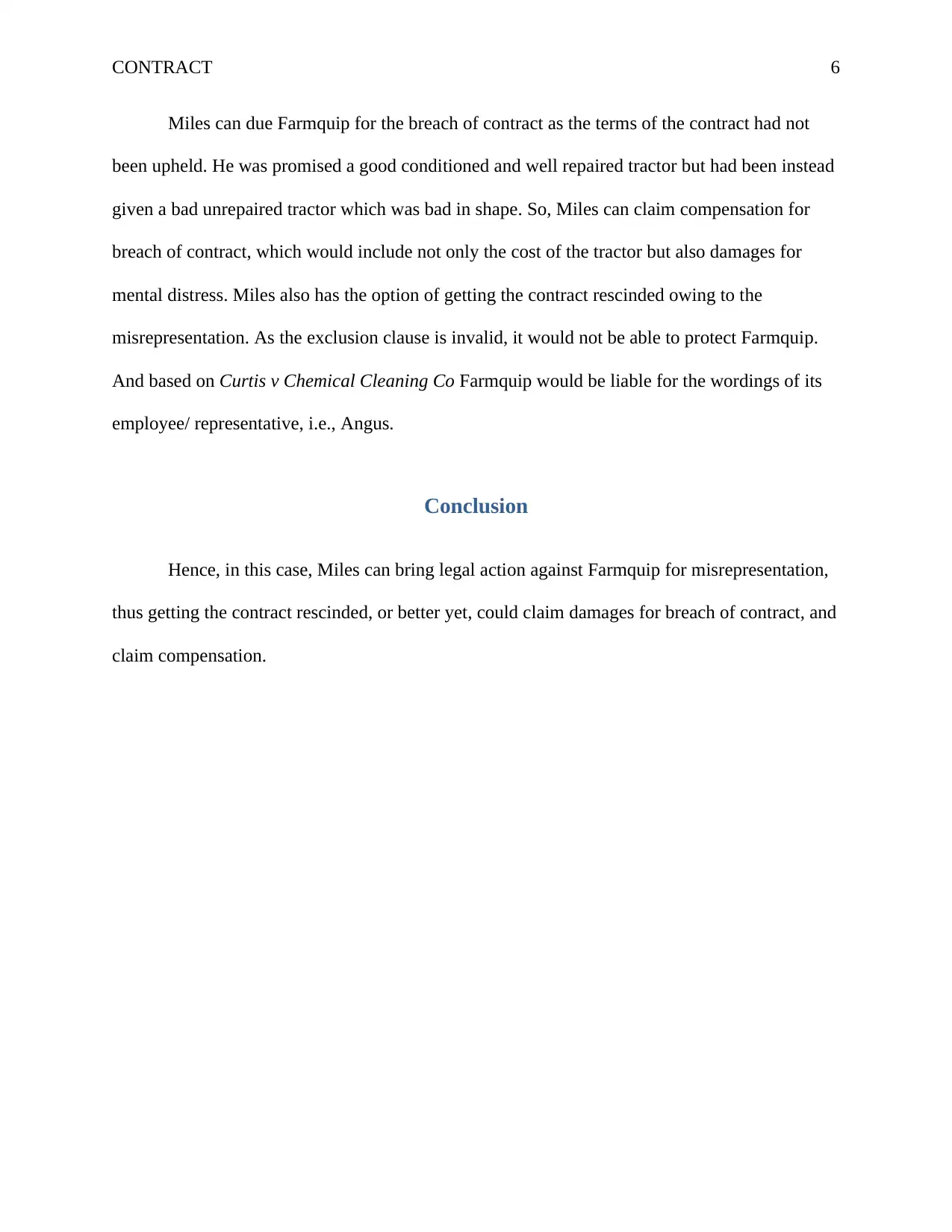
CONTRACT 6
Miles can due Farmquip for the breach of contract as the terms of the contract had not
been upheld. He was promised a good conditioned and well repaired tractor but had been instead
given a bad unrepaired tractor which was bad in shape. So, Miles can claim compensation for
breach of contract, which would include not only the cost of the tractor but also damages for
mental distress. Miles also has the option of getting the contract rescinded owing to the
misrepresentation. As the exclusion clause is invalid, it would not be able to protect Farmquip.
And based on Curtis v Chemical Cleaning Co Farmquip would be liable for the wordings of its
employee/ representative, i.e., Angus.
Conclusion
Hence, in this case, Miles can bring legal action against Farmquip for misrepresentation,
thus getting the contract rescinded, or better yet, could claim damages for breach of contract, and
claim compensation.
Miles can due Farmquip for the breach of contract as the terms of the contract had not
been upheld. He was promised a good conditioned and well repaired tractor but had been instead
given a bad unrepaired tractor which was bad in shape. So, Miles can claim compensation for
breach of contract, which would include not only the cost of the tractor but also damages for
mental distress. Miles also has the option of getting the contract rescinded owing to the
misrepresentation. As the exclusion clause is invalid, it would not be able to protect Farmquip.
And based on Curtis v Chemical Cleaning Co Farmquip would be liable for the wordings of its
employee/ representative, i.e., Angus.
Conclusion
Hence, in this case, Miles can bring legal action against Farmquip for misrepresentation,
thus getting the contract rescinded, or better yet, could claim damages for breach of contract, and
claim compensation.
⊘ This is a preview!⊘
Do you want full access?
Subscribe today to unlock all pages.

Trusted by 1+ million students worldwide
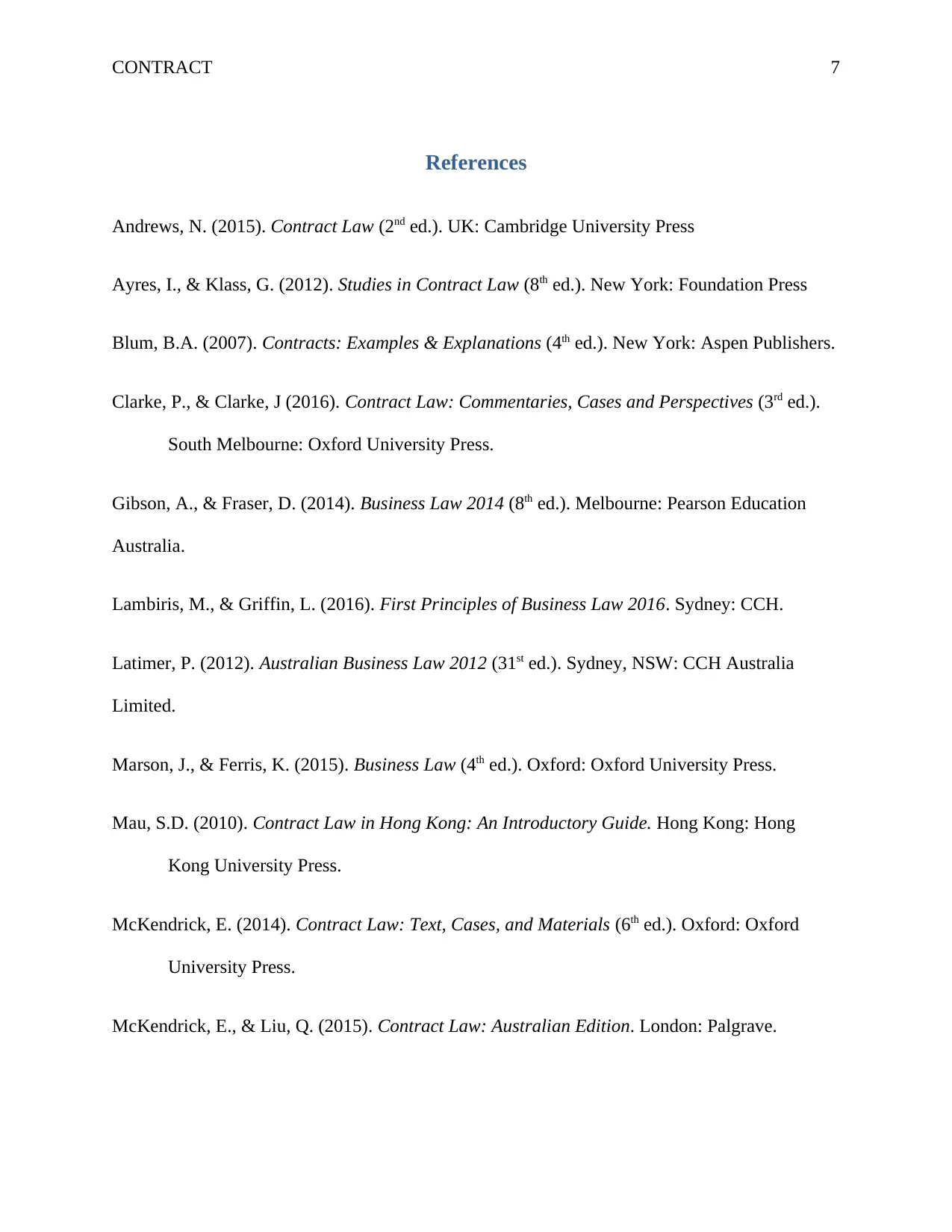
CONTRACT 7
References
Andrews, N. (2015). Contract Law (2nd ed.). UK: Cambridge University Press
Ayres, I., & Klass, G. (2012). Studies in Contract Law (8th ed.). New York: Foundation Press
Blum, B.A. (2007). Contracts: Examples & Explanations (4th ed.). New York: Aspen Publishers.
Clarke, P., & Clarke, J (2016). Contract Law: Commentaries, Cases and Perspectives (3rd ed.).
South Melbourne: Oxford University Press.
Gibson, A., & Fraser, D. (2014). Business Law 2014 (8th ed.). Melbourne: Pearson Education
Australia.
Lambiris, M., & Griffin, L. (2016). First Principles of Business Law 2016. Sydney: CCH.
Latimer, P. (2012). Australian Business Law 2012 (31st ed.). Sydney, NSW: CCH Australia
Limited.
Marson, J., & Ferris, K. (2015). Business Law (4th ed.). Oxford: Oxford University Press.
Mau, S.D. (2010). Contract Law in Hong Kong: An Introductory Guide. Hong Kong: Hong
Kong University Press.
McKendrick, E. (2014). Contract Law: Text, Cases, and Materials (6th ed.). Oxford: Oxford
University Press.
McKendrick, E., & Liu, Q. (2015). Contract Law: Australian Edition. London: Palgrave.
References
Andrews, N. (2015). Contract Law (2nd ed.). UK: Cambridge University Press
Ayres, I., & Klass, G. (2012). Studies in Contract Law (8th ed.). New York: Foundation Press
Blum, B.A. (2007). Contracts: Examples & Explanations (4th ed.). New York: Aspen Publishers.
Clarke, P., & Clarke, J (2016). Contract Law: Commentaries, Cases and Perspectives (3rd ed.).
South Melbourne: Oxford University Press.
Gibson, A., & Fraser, D. (2014). Business Law 2014 (8th ed.). Melbourne: Pearson Education
Australia.
Lambiris, M., & Griffin, L. (2016). First Principles of Business Law 2016. Sydney: CCH.
Latimer, P. (2012). Australian Business Law 2012 (31st ed.). Sydney, NSW: CCH Australia
Limited.
Marson, J., & Ferris, K. (2015). Business Law (4th ed.). Oxford: Oxford University Press.
Mau, S.D. (2010). Contract Law in Hong Kong: An Introductory Guide. Hong Kong: Hong
Kong University Press.
McKendrick, E. (2014). Contract Law: Text, Cases, and Materials (6th ed.). Oxford: Oxford
University Press.
McKendrick, E., & Liu, Q. (2015). Contract Law: Australian Edition. London: Palgrave.
Paraphrase This Document
Need a fresh take? Get an instant paraphrase of this document with our AI Paraphraser
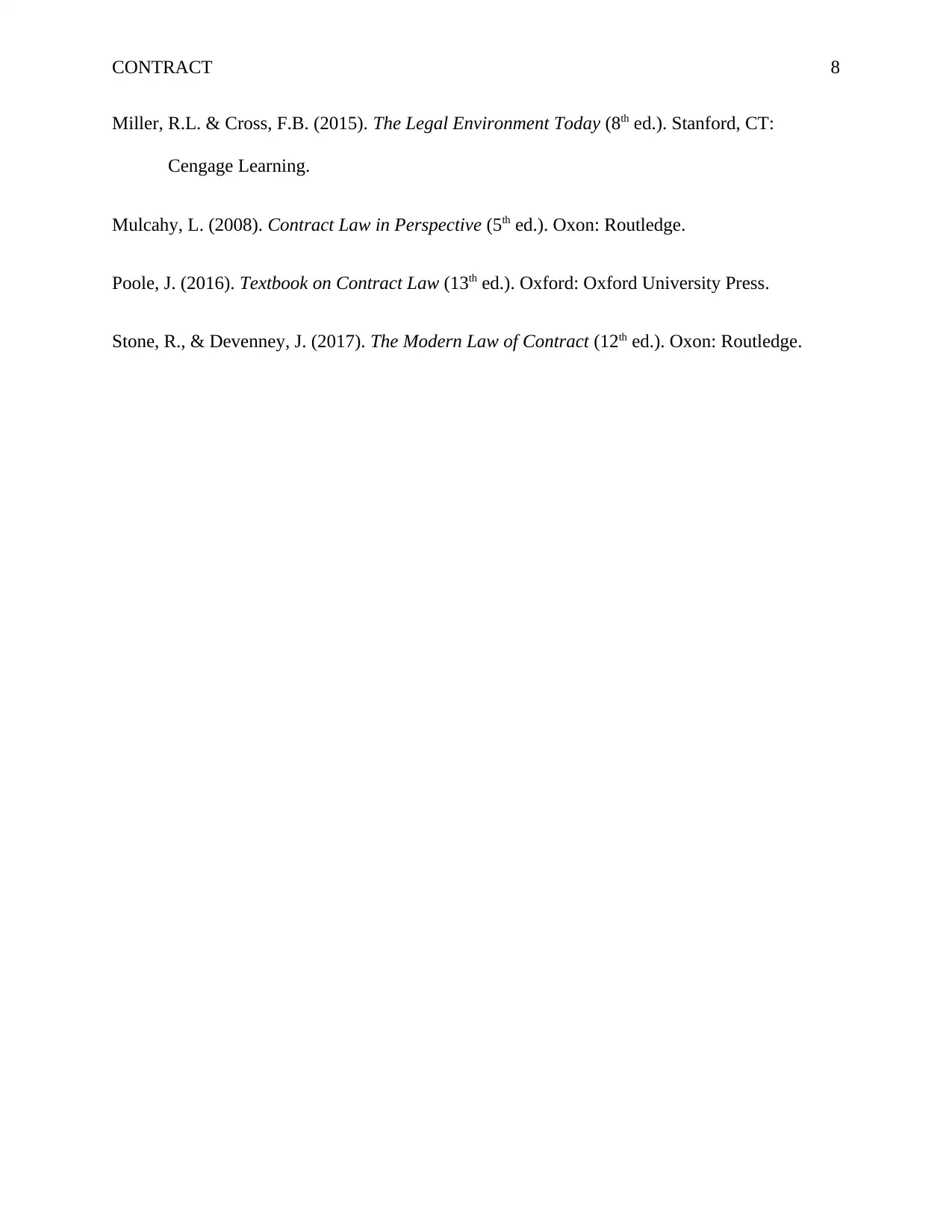
CONTRACT 8
Miller, R.L. & Cross, F.B. (2015). The Legal Environment Today (8th ed.). Stanford, CT:
Cengage Learning.
Mulcahy, L. (2008). Contract Law in Perspective (5th ed.). Oxon: Routledge.
Poole, J. (2016). Textbook on Contract Law (13th ed.). Oxford: Oxford University Press.
Stone, R., & Devenney, J. (2017). The Modern Law of Contract (12th ed.). Oxon: Routledge.
Miller, R.L. & Cross, F.B. (2015). The Legal Environment Today (8th ed.). Stanford, CT:
Cengage Learning.
Mulcahy, L. (2008). Contract Law in Perspective (5th ed.). Oxon: Routledge.
Poole, J. (2016). Textbook on Contract Law (13th ed.). Oxford: Oxford University Press.
Stone, R., & Devenney, J. (2017). The Modern Law of Contract (12th ed.). Oxon: Routledge.
1 out of 8
Related Documents
Your All-in-One AI-Powered Toolkit for Academic Success.
+13062052269
info@desklib.com
Available 24*7 on WhatsApp / Email
![[object Object]](/_next/static/media/star-bottom.7253800d.svg)
Unlock your academic potential
Copyright © 2020–2025 A2Z Services. All Rights Reserved. Developed and managed by ZUCOL.




